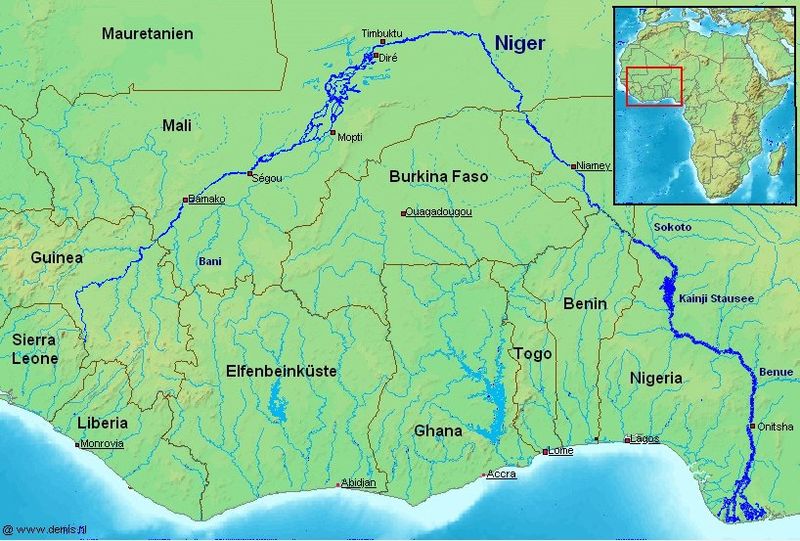
The Niger River: A Lifeline of Trade
The Niger River is one of Africa’s most significant waterways, playing a crucial role in trade, transportation, and economic development across multiple countries. Spanning approximately 4,180 kilometers (2,600 miles), it is the third-longest river in Africa, flowing through Guinea, Mali, Niger, Benin, and Nigeria before emptying into the Atlantic Ocean via the Niger Delta. This vast river network serves as a key transportation route, supporting commerce, agriculture, and local communities along its banks.
The Route of the Niger River
The Niger River follows a unique boomerang-shaped path, distinguishing it from other major rivers in the world. Its course can be divided into three major sections:
- Upper Niger (Source to Mali)
- The river originates in the Guinea Highlands, near the Sierra Leone border.
- It flows northeast into Mali, passing through Bamako, the capital city.
- This section supports local fishing communities and small-scale trade.
- Middle Niger (Mali to Nigeria)
- The river turns eastward through Niger and Burkina Faso, creating a fertile inland delta in Mali.
- This region is crucial for irrigation, sustaining crops and livestock.
- Major cities like Niamey (Niger’s capital) and Mopti (Mali’s trading hub) rely on it for transportation and commerce.
- Lower Niger (Nigeria to the Atlantic Ocean)
- The river enters Nigeria and continues southward through key cities such as Lokoja, Onitsha, and Asaba.
- At Aboh, it splits into multiple channels, forming the vast Niger Delta, one of the largest delta systems in the world.
- Finally, the river empties into the Atlantic Ocean through the Gulf of Guinea, making it a crucial trade route for inland and coastal shipping.
How the Niger River Links to the Atlantic Ocean
The Niger Delta, located in southern Nigeria, acts as the gateway connecting the inland river system to the Atlantic Ocean. This delta, covering about 70,000 square kilometers, is a vital economic region due to its:
- Deepwater Ports: Cities like Port Harcourt, Warri, and Calabar have major ports facilitating both domestic and international trade.
- Oil and Gas Industry: The region is rich in petroleum reserves, making it one of Africa’s most significant oil-producing areas.
- Maritime Trade: Goods such as agricultural products, minerals, and manufactured items are transported via the delta to global markets.
Through its natural waterways and man-made infrastructure, the Niger River plays a pivotal role in linking the interior of West Africa to global maritime trade routes.
The Importance of the Niger River in Trade and Transportation
Historically, the Niger River has been a major trade corridor, allowing goods, people, and cultures to move between regions. Its strategic role includes:
🚢 Inland Waterway Transport: The river serves as an efficient mode of transport for goods, reducing reliance on roads and railways.
🌍 Economic Integration: It connects landlocked countries like Mali and Niger to coastal economies, facilitating regional trade.
🚜 Agricultural Support: Many communities depend on the river for irrigation, fishing, and sustainable livelihoods.
🏗 Infrastructure Development: Bridges, ports, and ferry services enhance accessibility and promote commerce along its route.
Challenges and Future Prospects
Despite its immense benefits, the Niger River faces several challenges, including:
- Seasonal Flooding & Droughts – Climate change is affecting water levels, impacting agriculture and settlements.
- Pollution & Environmental Degradation – Industrial waste, oil spills, and deforestation threaten the river’s ecosystem.
- Navigation & Infrastructure Gaps – Many sections remain underdeveloped, limiting transport efficiency.
However, ongoing projects aim to modernize river transport, improve port facilities, and boost regional trade, ensuring the Niger River remains a vital economic and ecological resource for future generations.
Final Thoughts
The Niger River is more than just a waterway—it is a lifeline for millions, shaping the economic and cultural fabric of West Africa. Its connection to the Atlantic Ocean through the Niger Delta makes it a key driver of trade, infrastructure development, and regional cooperation. As countries invest in sustainable development and transportation networks, the Niger River will continue to serve as a crucial link between Africa’s interior and the global economy.

